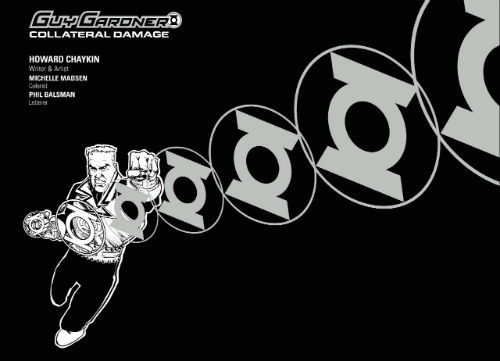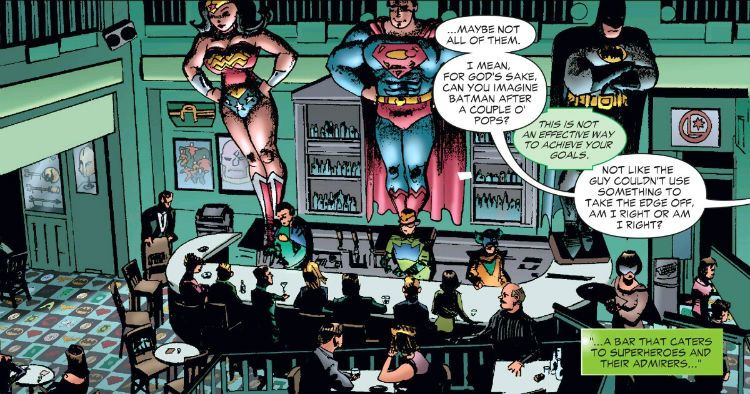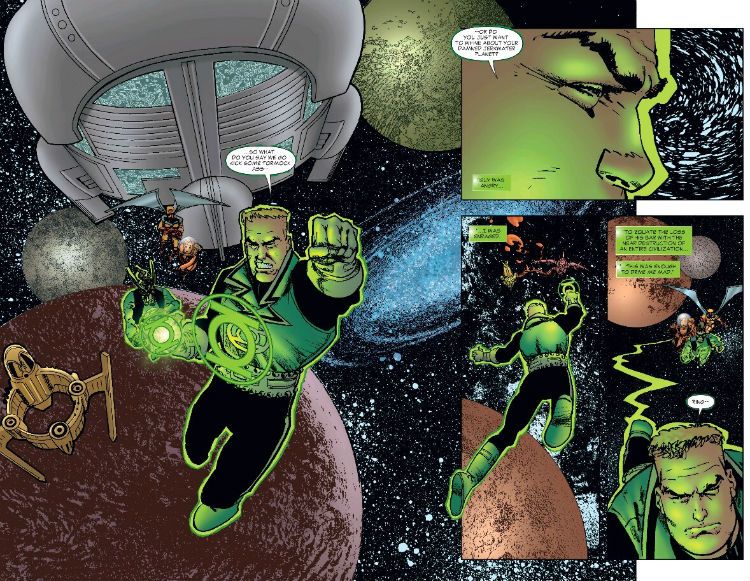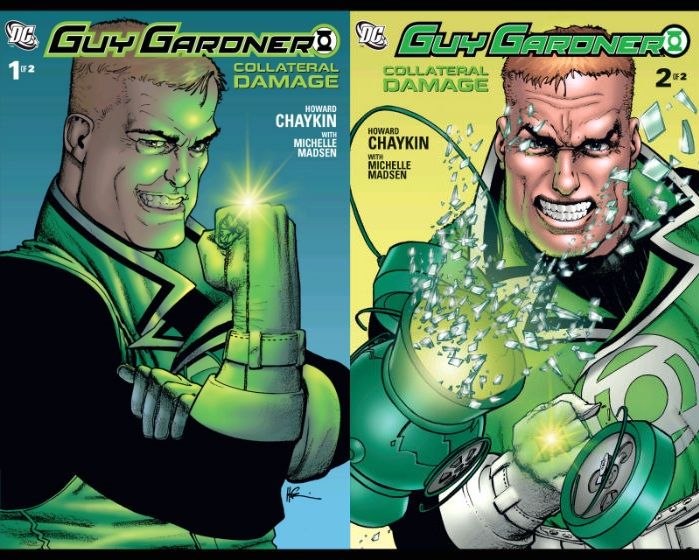“They Could Be A Crosstown Bus, A Croissant Or A Crossdresser By Now…” COMICS! Sometimes You Should Have Put A Ring On It!
/So I took a break and now I’m back! Like rickets! So here’s far more words than anyone sane would ever need to read about a two-issue comic Howard Victor Chaykin did in 2006. Because, that’s why. Just because. Also: because. Because.
 GUY GARDNER: COLLATERAL DAMAGE by Chaykin, Madsen & Balsman
GUY GARDNER: COLLATERAL DAMAGE by Chaykin, Madsen & Balsman
GUY GARDNER: COLLATERAL DAMAGE #1-2 Art by Howard Victor Chaykin Written by Howard Victor Chaykin Coloured by Michelle Madsen Lettered by Phil Balsman DC Comics (2006) Green Lantern created by Gil Kane, John Broome, Bill Finger, Martin Nodell and Gardner Fox Guy Gardner created by Gil Kane, John Broome G’Nort created by Keith Giffen & J. M. deMatteis
“Guy Gardner: Collateral Damage” is part of the second of Mount (as in “Mountain”; it’s not an instruction) Chaykin’s twin creative peaks. The first peak, as any fule kno, was in the ‘80s when Howard Victor Chaykin stopped putzing about and found his suave groove. In this period, covering “American Flagg!” thru to “Black Kiss”, Chaykin was amazing. The second, less trumpeted, peak occurred in the ‘00s and marked Howard Victor Chaykin’s full-time return to comics after toiling in the soulless arena of Television for much of the ‘90s. What he did in Television was make money, any more detail and you’ll need someone who gives a shit about Television. A comic writer with an Image book, say. Me, I think a talking car was involved and some Marvel show about mutants; I’m already falling asleep, zzzzzzz. Anyway, everyone needs money so whatever and well done to him. Howard Victor Chaykin burst back onto the comics scene with “Mighty Love”, and followed it with a fiesta of fun concepts, nut-tight art, smart scripting and…no one gave much of a shit, to be honest. Which is a stain on Comics’ collective Report Card. (Also, Comics must try harder in gym and stop being so easily distracted, there are no jobs out there for class clowns.) Luckily I am here to heroically, singlehandedly and, above all, modestly rescue Howard Victor Chaykin’s ‘00s output from the ignominy of thoughtless neglect. I picked “Guy Gardner: Collateral Damage” because as we’ll see it is an unlikely place (a continuity burdened Event tie-in) for his characteristic strengths to find purchase. But, like Nature, Howard Victor Chaykin finds a way. Also I’d just bought it on The ‘Ology.
 GUY GARDNER: COLLATERAL DAMAGE by Chaykin, Madsen & Balsman
GUY GARDNER: COLLATERAL DAMAGE by Chaykin, Madsen & Balsman
Yes! This aptly named series originally appeared in 2006 as two “prestige” format comics and is now available in 2017 digitally (and, crucially, cheaper) on the ‘Ology. This means I can write about it without breaking the spines of my originals while scanning them. (Such are the trials which mar my life!) The book lived up to its title (“Collateral Damage”, see) by being barely noticed on publication due to most eyes being filled to the brim by the rest of the “Infinite Crisis” lardfest, of which this was but one small part. In the same way that “House of M” (2005) sounded the death knell for my interest in Marvel’s output, “Infinite Crisis” would place the pillow over the face of my interest in DC and begin to apply pressure. Lest we forget, because after all it was 11 years ago now, “Infinite Crisis” was the core series in which Geoff Johns wrote a load of typically mawkish continuity-chuff drizzled in saucy gore, and peppered with his childish resentment at internet commentators; all in an attempt to hornswoggle the audience into believing something of merit and depth had occurred. (It hadn’t.) Worse, there were ancillary mini-series like “The Rann-Thanagar War”, which, while decently written, was a waste of the unique talents of Dave Gibbons. Getting Dave Gibbons to write corporately mandated tie-ins to short-term sales bloating events is a bit like getting Isambard Kingdom Brunel in to unblock your sink because the boss is coming round for dinner. It’s unseemly, and speaks to a total lack of appreciation of his gift. Which is the ability to draw real well, DC Comics. I thought I should spell that out for you; although I guess for DC the real gift of Dave Gibbons is his ability to maintain a dignified silence while they fart once more into the face of “Watchmen”’s corpse. Although there is a certain grim irony in the fact that DC’s latest attempt to reduce one of the (very few) decent cape comics into something they can eventually team-up with Scooby fucking Doo starts with Batman finding a “Watchmen” promotional button in his cave. After all DC’s underhand antics with promotional badges are what started the whole sorry “Let’s All Hunt And Kill Alan Moore” shitshow off aren’t they? (Yes.)
 GUY GARDNER: COLLATERAL DAMAGE by Chaykin, Madsen & Balsman
GUY GARDNER: COLLATERAL DAMAGE by Chaykin, Madsen & Balsman
But this isn’t about that, this is about a Howard Victor Chaykin comic which was secreted somewhere within muddled parpstorm of a terrible Event. An Event so larded in extraneous chaff that I’ve hardly even begun to scratch the surface. I can’t even be arsed to look it up, so demoralising is the memory of all that Trex, so I may have a few facts wrong when I say there was also “The OMAC Project” which involved Greg Rucka, so it was probably a bit like drowsing while watching a TV show about a strong! independent! female! written with all the élan and excitement of a spreadsheet macro; “Villains United” which tried to make Catman a sexy badass, so enough said there, and a series about the return of Donna Troy (imaginatively and thrillingly entitled “The Return of Donna Troy”) which I imagine no one read, since no one shares DC’s insane belief in the character of Donna Troy. Although it is sobering to note that they have treated Donna Troy, a fictional character, with more love and respect than they have treated Alan Moore, a real human being. Maybe Alan Moore should start wearing a tight cat suit with little stars on it; it wouldn’t change anything but I think the world would be fundamentally a far sexier place. He could maybe jump around a bit and giggle for Peak Sexy. Uh, anyway, Donna Troy, I don’t know; that probably went about as well as expected, I think they found her weeing in a grate outside IKEA while singing showtunes. I could be wrong. Oh, and then all the regular DC series had a tie-in of some description, that description probably involving the terms “irritating”, “disruptive” and “unwelcome”. Best of all (i.e. worst of all) every title then zipped forward 12 months and the series created specifically to fill in this blank, “52”, didn’t. But everyone writing it had fun and readers did get to see small child torn to pieces by a talking crocodile, which is worth more than rubies to Geoff Johns. In essence the “Infinite Crisis” Event turned out as well as any Event could which starts off with the chirpy schmuck Blue Beetle’s brains being blown out. Fucking grown up stuff, that. If I have made any errors in that brief rundown I want to assure you now that I don’t care. Not a jot. What is undeniable is that the only worthwhile reason to brave this blizzard of inconsequential pablum was Howard Victor Chaykin; who, working diligently away in a neglected corner of the DC Universe, produced another Howard Victor Chaykin comic.
 GUY GARDNER: COLLATERAL DAMAGE by Chaykin, Madsen & Balsman
GUY GARDNER: COLLATERAL DAMAGE by Chaykin, Madsen & Balsman
Given the nature of the Event beast Howard Victor Chaykin must here sup from the cup of continuity somewhat deeper than is his wont, yet Chaykin still ably finagles his way into writing what he’d rather be writing about: a horny jackass accidentally doing the right thing for all the wrong reasons. First though he has to pay lip service to the corporate tie-in friendly setup, which is that G’Nort (AKA G'nort Esplanade G'neesmacher the canine looking alien Green Lantern) is looking for an independent entity to broker peace between Rann (the planet of boffins Adam Strange knocks about with) and Thanagar (the planet of winged fascists like that Hawkman). Caught between these two cheeks of the same warmongering arse G’Nort’s home planet has fared poorly. What with his family having being offed the usually played for laffs character is thus portrayed as a bitter champion of peace. An upright talking dog with a magic wishing ring rancorously lamenting its slaughtered family is a pretty good joke about “gritty” superheroes, I think. So, back at the point: G’Nort chooses Guy Gardner, who is the “edgy Green Lantern”. Since the only Green Lantern I have any familiarity with is Hal Jordan, in comparison to whom even I appear “edgy”, I don’t really know how “edgy” Guy Gardner is usually. I’m not really interested either. Here Howard Victor Chaykin writes Guy Gardner as “Howard Victor Chaykin” (Legal Note i.e. not really Howard Victor Chaykin but the cartoonish exaggeration he uses as his default protagonist. Hence the rabbit’s ears round his name.) Or “Howard Victor Chaykin” if he owned his own bar (namely Warriors: “…the finest meat rack the world’s ever seen”) and had a magic wishing ring. It goes without saying that this is the single best set up for a series ever, ever, ever and the very real tragedy is we only have two issues. To recap for Green Lantern newbs: If you stick your finger in Guy Gardner’s ring and make a wish, that wish briefly becomes a physical, but green, reality. But should you stick your finger in Howard Victor Chaykin’s ring and make a wish you end up with a few less teeth and a restraining order. A little lesson in the difference between fantasy and reality there, kids. So, yeah, since there’s a six-issue mini-series occurring somewhere beyond these pages about the Rann-Thanagar War the whole peace process business is a bit of a McGuffin. Okay, a lot of a McGuffin. Everyone gathers in Guy’s bar and then the Tormocks burst in and wreck it and the comic forgets what it was supposed to be about while Guy goes and finishes off the Tormocks. The Tormocks having just finished off the Vuldarian race. I just looked on Wikipedia and, oh wow, it turns out Guy Gardner is the first successful example of the merging of Vuldarian (the Tormock’s hated enemies) and human DNA. Guy was also born in Baltimore, Maryland. There are people out there who know all that but don’t know who their MP is. Think about that for a minute. This comic is a lot of fun but not quite as much fun as imagining Howard Victor Chaykin’s face as he read Guy Gardner’s backstory. Bojemoi!
 GUY GARDNER: COLLATERAL DAMAGE by Chaykin, Madsen & Balsman
GUY GARDNER: COLLATERAL DAMAGE by Chaykin, Madsen & Balsman
Given his oft expressed preference for comics’ form over comics’ content I was amazed that Chaykin had immersed himself in Guy Gardner’s typically ridiculous (not a criticism) continuity to the extent he had, but it’s all part of Chaykin’s sleight of hand as he refocuses the tie-in not too subtly onto his pet concerns. Basically the Tormocks allow him to provide his arrogant schmuck of a protagonist with the usual “moral cripple” opposition. Since Guy Gardner is the “hero” it’s important he come into conflict with someone demonstrably worse. Which is kind of tough because Gardner is a leering oaf, a blunt concoction of braggadocio, poor impulse control and genitally driven self-interest. And he also has the worst haircut in comics. The guy’s a walking pile of soiled jock straps with all the self-awareness of a stump. Much of the comedy comes from Chaykin nakedly embracing Guy’s faults, with only Guy’s wishing ring’s sardonic commentary, acting as a kind of unheeded conscience, as a balm to the buffoonish sexism on display. I kid you not when I say there are no less than three panels in which Gardner is clearly ogling a boob while talking to its owner, and his interest in heroism is a poor second to his interest in troilism. Even back when it was just called dickheadedness Chaykin showed a concern with toxic masculinity, a concern which persists in his work. Because he doesn’t actively undermine it to the extent people expect someone to I think he gets a raw deal, and people interpret his depiction as an endorsement. (Also it’s easier to dismiss him that way.) Chaykin’s mature (i.e. Flagg! onwards) work is festooned with protagonists hampered by their toxic masculinity. Usually violent, sexually aggressive and emotionally restricted many of Chaykin’s male leads are walking (but charming) embodiments of toxic masculinity. But the stories they inhabit are often misinterpreted as celebrating this, because Chaykin doesn’t tut and shake his head enough to sate political correctness. Yet Chaykin’s usually kneecapping male bravado as thoroughly as a bolt gun. in “American Flagg!” our cocky protagonist is brought firmly down to earth, only prevailing through fear driven violence and ending a weeping wreck in the arms of a woman despite all the swagger of preceding issues. “Midnight Men” is as much about a man breaking out of the emotional inertia of maleness so he can finally mourn his father, as it is about the joys of punching assholes in the face. Blackhawk doesn’t win by fighting, he wins by thinking. Cass Pollack in “Black Kiss” is thoroughly punished, emasculated even, for his moral feebleness. And Guy Gardner, well, Guy Gardner is just an unrepentant prick. And remains so. Which is fine, but it makes it hard to root for him. Hence the Tormocks. This bunch of charmers are basically engaged in ethnic cleansing on a universal scale, and not only kill people but turn them into a kind of paste and then get schwifty while rolling about in it. So, yeah, as unrepentant as he may be Guy Gardner doesn’t look too bad in comparison. I’ll take toxic males over space Nazis anyoldday.
 GUY GARDNER: COLLATERAL DAMAGE by Chaykin, Madsen & Balsman
GUY GARDNER: COLLATERAL DAMAGE by Chaykin, Madsen & Balsman
Visually, Chaykin returned from Television with a new lucidity and boldness which the pages of “Guy Gardner: Collateral Damage” testify loudly to. His figures are big and his layouts regimented. It’s easy to rip the piss out of the predictability of his layouts, with their strict regime of vertical or horizontal panels interrupted by insets, but it works because his aim is clarity, not pizzazz. Sometimes his aim’s off though. No, it’s not all unrestrained gushing from my end (ooer!), Chaykin’s pages definitely work best on the horizontal pattern; the vertical doesn’t give him enough space to stage action, which he forgets sometimes. Confusion ensues. (A dependency on vertical panels would somewhat tarnish, and for some fatally undermine, the many other pleasures of the later “Century West” OGN) Mostly though it’s good lookin’ stuff! There’s a real bounce to it all, a real sense Chaykin’s having a good time. This pleasure is particularly evident in the glee with which he yanks back the clock on the sci-fi stuff. Chaykin’s space jalopies are fantastically old school, each a knowing throwback to the thrilling days of yesteryear. Specifically 1938-40, when Olympic swimmer Larry “Buster” Crabbe (1908-1983) was so virile he portrayed not just Flash Gordon but Buck Rogers to boot. With their rococo ornamentation and redundant aerodynamic tapering Chaykin’s ships just need a fire cracker stuck up the jacksie and to be hoisted aloft by wires moving in a circular but persistently vertical motion. (Also, I’m pretty sure one of the characters is using a hairdryer as a gun at one point.) This obvious affection for the outmoded, impractical but beautiful would find later and fuller expression in Chaykin’s “Buck Rogers” revamp. Here though it’s super heroes a-go-go and Chaykin goes appropriately brash and big with the figurework. Surely no heart can remain unmoved by the five (count them: five!) double page splashes which open the book in a suitably dynamic and sweeping style. Oh yeah, there’s also some debonair styling going on as Chaykin continues his wholly understandable love affair with the visual of a man in a nice suit. And woven in among it all are some sweet little touches of humour, such as the repeating GL symbol on Guy’s tie. It helps that the book’s coloured by Michelle Madsen, whose contribution to this ‘00s second peak period of Chaykin is considerable. Embracing lurid and fruity colours as befits such a lurid and fruity book, Madsen’s colouring here is delightfully essential rather than dutifully unobtrusive. The lettering is fine, but it’s not Ken Bruzenak. It’s fine though. But not Ken. Okay I’ve run out of time so “Guy Gardner: Collateral Damage” is undoubtedly a minor work by a major talent, but it’s still VERY GOOD! Let those who worship evil’s might, beware my power – COMICS!!!












